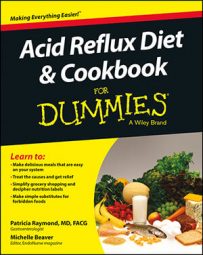The most common surgical procedure for relieving the symptoms of gastroesophageal reflux disease (GERD) — and one that has been around for years — is the Nissen fundoplication, which has about an 85 percent success rate in relieving reflux symptoms and healing inflammation of the esophagus.
The procedure involves wrapping the upper stomach, or fundus, around the lower part of the esophagus. Think of it like a hot dog (the esophagus) in a hot dog bun (the stomach) — hold the relish and mustard. This procedure compresses the lower end of the esophagus, and this compression prevents reflux.
The higher pressure in the lower esophageal sphincter (LES) area occurs only when you need it — when food is in your stomach and the food-filled wrapped stomach “smooshes” the esophagus.
There is a lot of variety in terms of how surgeons do their Nissens, including how tightly the “bun” wraps the “hot dog,” whether the “hot dog” sits atop the “bun” or is completely enveloped by it, and the length of “hot dog” and “bun” involved.
All the procedures have different names, but at the heart they’re derivatives of the classic Nissen. The Nissen fundoplication also may be performed open (with a traditional surgical incision) or closed (via laparoscopy). Laparascopic (“lap”) Nissens have similar results to conventional open surgery, with shorter recovery times.
A Nissen fundoplication isn’t perfect. After surgery, a disappointed 10 percent to 65 percent of patients still require some form of antiacid medication. However, the reflux is mostly less severe than in the pre-op state. And surgery carries, as always, the usual risk of complications, including bleeding, infection, perforation, and risks from anesthesia.
If you’re thinking that 10 percent to 65 percent is a huge range, you’re right, but that’s the data. Some studies select for folks with good response to medications, and they’re more likely to have good outcomes. The people with breakthrough symptoms despite maximum drugs tend to have disappointing outcomes.
Doctors think it may have something to do with having a sensitive esophagus, not the quantity or acidity of the material getting through. Bottom line: No procedure works for everyone.
Side effects of a Nissen include the gas-bloat syndrome. In addition, a tightly wrapped Nissen may cause difficulty swallowing in an esophagus that moves well.
It’s important to have the motility (movement) test of the esophagus before having this surgery — if the esophagus itself (in addition to the LES) is weak, it’s a recipe for disaster to then have a Nissan done and have your esophagus fail to get Aunt Mary’s fried chicken all the way through the wrap to your stomach.
Some new endoscopic methods are being developed that tighten the sphincter with a suture or staple placed from the inside. Our advice: Don’t be an early adopter on a new endoscopy or surgical procedure unless you’re out of options.
Sometimes new procedures have significant complications and end up being discontinued. Let somebody else be the guinea pig, if possible, and stick with the tried and true. Or wait until the new technique has some mileage under its tires.

